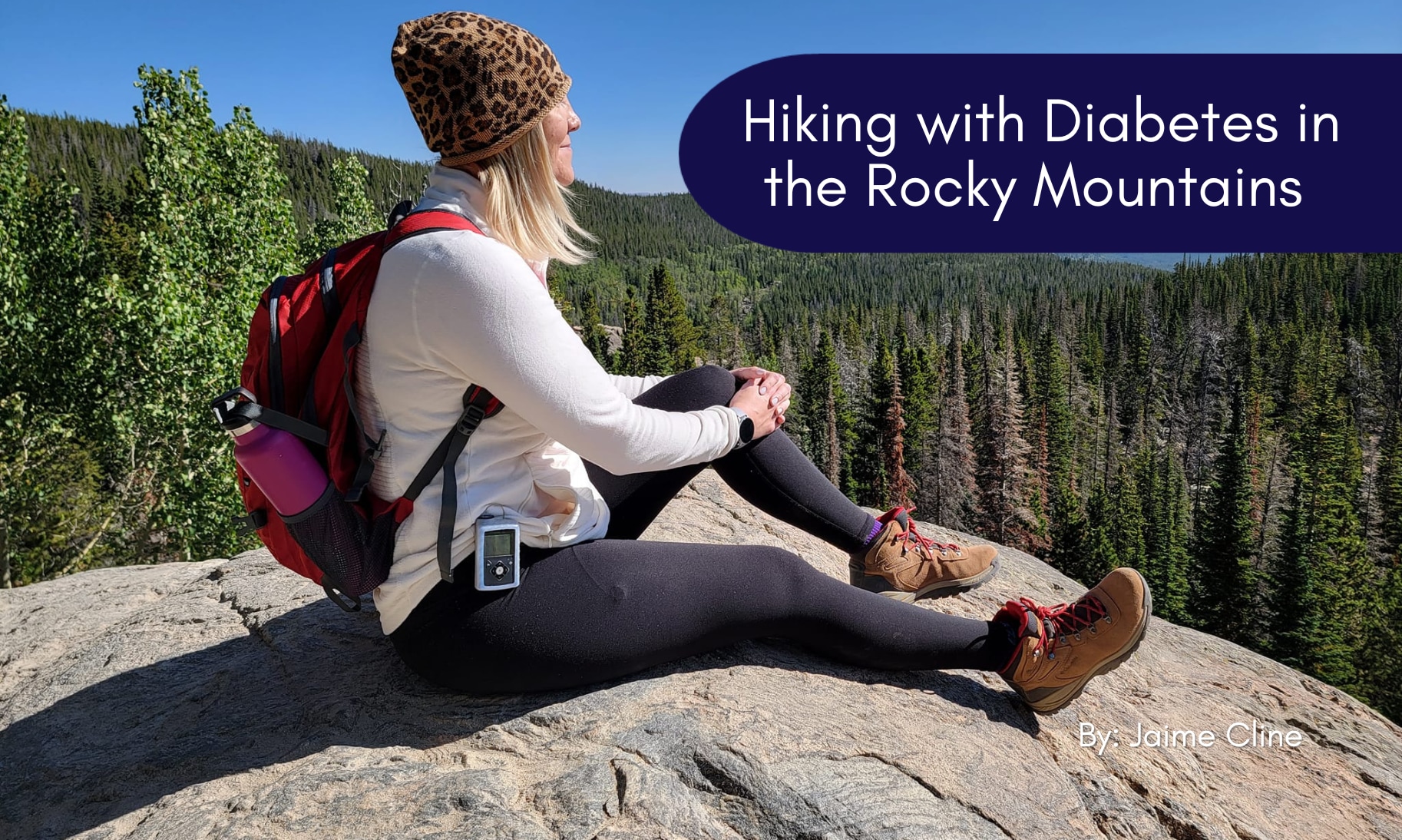Hiking with diabetes in the Rocky Mountains

My name is Jaime and I have type 1 diabetes. I was diagnosed when I was three years old and have never let diabetes stop me from living a life full of adventure, travel, and joy-filled experiences. My most recent adventure was a hiking trip to Colorado to hike Rocky Mountain National Park with my dad and little sister.
Hiking with diabetes
I won’t lie—when I first thought about hiking with diabetes, I was a bit worried.
How was I going to be able to sustain that amount of physical activity for a long period of time?
What would happen if I had a low blood sugar out on the trail?
What if I didn’t have enough snacks?
Was I strong enough to make the climb?
What if something happened to my insulin pump or CGM?
How much water would I have to bring to avoid dehydration?
What if I have a really bad low, we have to get air-lifted down the mountain, and I ruin our trip?
What are the chances of getting eaten by a bear? (Ok this was pretty unlikely, but I still thought about it. Enough that I bought bear spray and a whistle to scare them off.)
It was a lot to think through, but it wasn’t an impossible task—I would just need to plan ahead and take a few extra precautions to keep myself safe on the trails. Keep in mind, I’m definitely not a health care professional so I’m just going to share what worked for me. I’m a firm believer in supporting everyone’s unique diabetes journey so you should make an appointment with your doctor to talk through planning your next adventure or travel experience. 😊
Having support helps
One thing that worked in my favor was I was going with people that were already very familiar with type 1 diabetes, what a low blood sugar looks like, and how to help me if I were to have one on the trail. I think I might have stressed out a bit more if I had been going with people that were not knowledgeable about my disease and all of the things I need to do to manage it. Luckily, my family knows the specific signs of my low blood sugars—I get pretty disoriented, shaky, and sweaty. They know that they need to get me some sugar quickly and to let me get my glucose levels back in range before we begin hiking again. That was a pretty reassuring for me and made me feel a lot more comfortable lacing up my hiking boots.
Be prepared
As we stepped into Rocky Mountain National Park, the majestic sweep of the mountains took my breath away. The weight of my backpack also took my breath away!
Snacks
I had packed enough snacks for a week. I wanted to be prepared so I packed all the things. Exercising in general with diabetes can be challenging—without the added layer of being in the wilderness, away from people that could help me, access to readily available food, and potential loss of a phone signal. I had to be prepared for the worst-case scenario even if that meant I felt like I "overpacked" at the end of the day. Snacks that I packed:
- sweetened dried mangos
- gummy worms (my go-to low blood sugar snacks)
- beef jerky
- granola bars
- glucose gel
- electrolyte drink mixes I could add to my water
I made sure to put the snacks in a couple easy-to-access locations in my hiking backpack and shared the locations with my family in case they needed to help me. I also made sure to tuck a few things in my pockets I could easily reach if I got the alert on my CGM that I was dipping low.
Diabetes bag
Including the 10 pounds of snacks I packed, I also made sure to include some extra diabetes supplies:
- infusion sets
- reservoirs
- sensors
- needles
- extra insulin
- a cold pack for insulin storage in my backpack
Logistically, I knew that we would only be going out on the trail for the day and returning to the cabin at night, but I didn’t want to risk the chance that I would accidently catch my pump tubing on a random tree branch, have it rip out, and have to cancel our hike for the day. If something happened on the trail with my diabetes equipment—I was prepared!
Count each win
Luckily, the weight of my backpack and the weight of my diabetes didn’t overwhelm me on this trip. Instead, it reinforced the idea that I’ve always held—that weight makes me stronger.
Carrying a 10-pound backpack while hiking 10+ miles a day in a higher elevation* challenged my body in a way my daily visits to the gym definitely don’t do. Hiking with diabetes in the Colorado wilderness also reminded me of how strong I truly am.
Much like a 10-pound backpack, I carry around the weight of managing a chronic disease every day -- one that I’ve managed on my own for 30+ years, where I’m in charge of my survival. I carry the weight of having to plan, schedule, anticipate, and strategize every single day to keep myself healthy. There are no breaks, no vacations, no-time outs from diabetes.
The weight never lifts.
But strapping on my 10-pound backpack, lacing up my comfy hiking boots, and setting my pump to its Temp Target of 150 each day…I felt like I could carry the weight.
Because I know I’m strong enough.
*The testimonial above relates an account of an individual’s experience using a Medtronic device. The account is genuine, typical and documented. However, this individual’s experience does not provide any indication, guide, warranty or guarantee as to the response or experience other people may have using the device. The experience other individuals have with the device could be different. Experiences can and do vary. Please talk to your doctor about your condition and the risks and benefits of Medtronic devices.
Medtronic Diabetes pumps work at altitudes below 10,000 feet above sea level. Confirm your device’s altitude range before engaging in sporting activities.
MiniMed™ pumps are designed to withstand temperatures between 41- 104°F. Insulin can freeze near 32°F and become less effective at higher temperatures.
Important Safety Information: MiniMed™ 770G System with SmartGuard™ Technology
The MiniMed™ 770G system is intended for continuous delivery of basal insulin (at user selectable rates) and administration of insulin boluses (in user selectable amounts) for the management of type 1 diabetes mellitus in persons two years of age and older requiring insulin as well as for the continuous monitoring and trending of glucose levels in the fluid under the skin. The MiniMed™ 770G System includes SmartGuard™ technology, which can be programmed to automatically adjust delivery of basal insulin based on continuous glucose monitoring (CGM) sensor glucose values (SG) and can suspend delivery of insulin when the SG value falls below or is predicted to fall below predefined threshold values.
The Medtronic MiniMed™ 770G System consists of the following devices: MiniMed™ 770G Insulin Pump, the Guardian™ Link (3) Transmitter, the Guardian™ Sensor (3), one-press serter, the Accu-Chek® Guide Link blood glucose meter, and the AccuChek®Guide Test Strips. The system requires a prescription.
The Guardian™ Sensor (3) has not been evaluated and is not intended to be used directly for making therapy adjustments, but rather to provide an indication of when a fingerstick may be required. All therapy adjustments should be based on measurements obtained using a blood glucose meter and not on values provided by the Guardian™ Sensor (3).
All therapy adjustments should be based on measurements obtained using the Accu-Chek® Guide Link blood glucose meter and not on values provided by the Guardian™ Sensor (3). Always check the pump display to ensure the glucose result shown agrees with the glucose results shown on the Accu-Chek® Guide Link blood glucose meter. Do not calibrate your CGM device or calculate a bolus using a blood glucose meter result taken from an alternative site. It is not recommended to calibrate your CGM device when sensor or blood glucose values are changing rapidly, e.g., following a meal or physical exercise.
WARNING: Do not use the SmartGuard™ Auto Mode for people who require less than 8 units or more than 250 units of total daily insulin per day. A total daily dose of at least 8 units, but no more than 250 units, is required to operate in SmartGuard™ Auto Mode.



